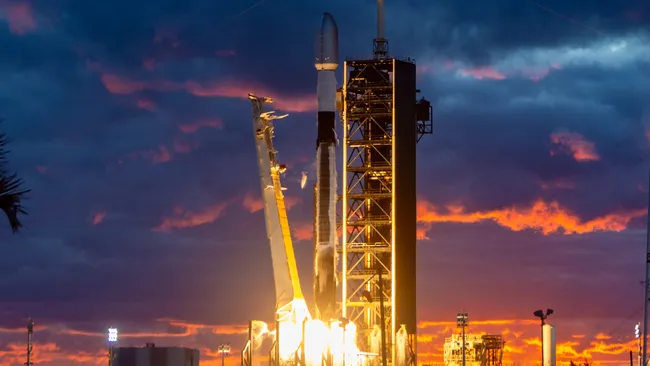 |
| On November 17, 2024, a SpaceX Falcon 9 rocket successfully launched the Optus-X telecommunications satellite from NASA's Kennedy Space Center in Florida. (Image credit: SpaceX via X). |
On the evening of November 17, 2024, SpaceX achieved another milestone with the successful launch of the Optus-X satellite for the Australian telecommunications company Optus. The Falcon 9 rocket lifted off from the iconic Pad 39A at NASA's Kennedy Space Center in Florida at precisely 5:28 p.m. EST (2128 GMT), just as the sun began to set, painting the sky in stunning hues of orange and pink.
A Spectacular Evening Launch
The launch was a breathtaking spectacle, with the Falcon 9 rocket piercing the darkening sky, leaving behind a trail of smoke and fire. Images captured during the event showcased the rocket in striking black and white against the backdrop of the twilight sky, emphasizing the beauty and power of modern space exploration.
Successful Booster Recovery
Approximately nine minutes after liftoff, the Falcon 9's first stage executed a flawless return to Earth, landing vertically on SpaceX’s droneship, “A Shortfall of Gravitas,” stationed in the Atlantic Ocean. This marked the 16th successful launch and landing for this particular booster, underscoring SpaceX's commitment to reusability and efficiency in its launch operations. Notably, nine of these missions have been dedicated to expanding SpaceX's Starlink megaconstellation in low Earth orbit (LEO), a testament to the company's innovative approach to satellite deployment.
Optus-X's Journey to Geostationary Orbit
While the Falcon 9 rocket is known for its missions to LEO, the Optus-X satellite has a different destination. The rocket's upper stage was tasked with delivering the satellite to a geosynchronous transfer orbit (GTO), from where Optus-X will maneuver itself to geostationary orbit. This orbit, located approximately 22,236 miles (35,786 kilometers) above Earth, allows satellites to remain fixed over a specific point on the planet, making it ideal for telecommunications.
A Bright Future for Telecommunications
The successful launch of the Optus-X satellite is a significant step forward for Optus, enhancing its capacity to provide reliable telecommunications services across Australia. With the growing demand for connectivity, especially in remote areas, satellites like Optus-X play a crucial role in bridging the digital divide.
As SpaceX continues to push the boundaries of space technology, this launch exemplifies the company's dedication to innovation and its ability to support global telecommunications initiatives. With each successful mission, SpaceX not only strengthens its position in the aerospace industry but also paves the way for a more connected world.
In conclusion, the launch of the Optus-X satellite marks another remarkable achievement for SpaceX and a bright future for telecommunications in Australia. As the company continues to revolutionize space travel and satellite deployment, the possibilities for global connectivity are expanding like never before.
